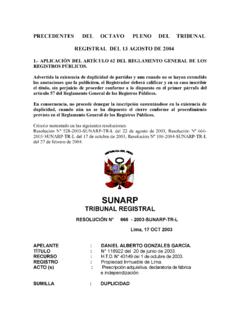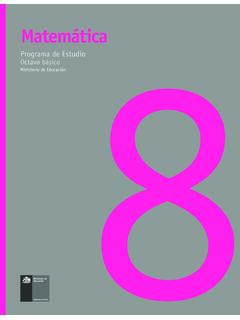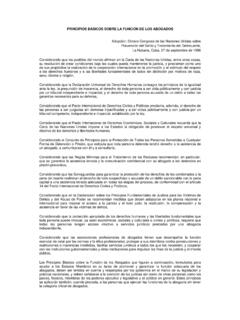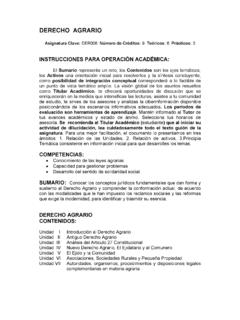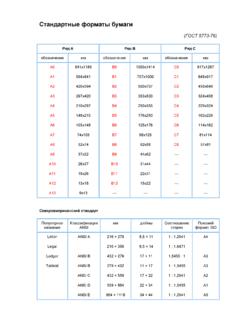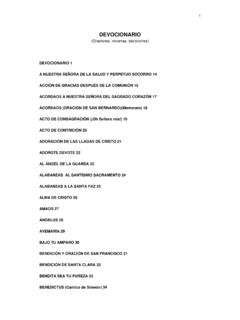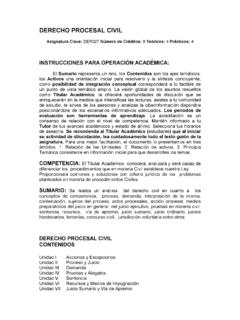Transcription of Español – octavo grado - hasd.org
1 Espa ol octavo grado 2011-2012 (primer semestre) Me llamo _____ Hora ___ Maestra _____ En la clase de espa ol Expresiones importantes Me permite .. ir al ba o? ..tomar agua? .. ir a mi casillero? .. ir a la oficina? .. ir a la enfermera? Gracias! Thank you. C mo? Qu ? What? Repite, por favor. Repeat please. No comprendo. I don t understand. M s despacio, por favor. Slower please. Qu quiere decir ____? What does ____ mean? Qu significa ____? What does ____ mean? C mo se dice ____? How do you say ____? Qu p gina? What page? C mo se escribe ____? How do you write/spell ____? Hay preguntas? Are there questions? Saca la tarea, papel, etc. Take out the homework, paper, etc. Mira la pizarra. Look at the board. Toma apuntes. Take notes.
2 Lee en voz alta. Read aloud. Traduce. Translate. Levanta la mano. Raise your hand. Preg ntale a tu compa ero. Ask your partner. Contesta. Answer. Recuerda. Remember. TAREA homework PRUEBA quiz EXAMEN test NOTAS grades AA Spanish Language Performance Assessments There are three major modes of assessment used in the Spanish language curriculum. They are interpretive, presentational, and interpersonal. These descriptions will help clarify what these three modes of communication entail. Interpretive Assessment Demonstrating comprehension of spoken or written Spanish. Presentational assessments: Formal, prepared, practiced and polished written or oral presentations. 1. Use what you ve learned in the unit being assessed. You are assessed based on what you show you know2. Use your workbook to incorporate vocabulary and grammar structures from the unit.
3 If it is not on your paper or you do not say it the teacher assumes you did not learn it. 3. Write your draft in Spanish4. Start early. You need time to re-write and correct. (practice/polish) , not English. 5. DO NOT USE A TRANSLATOR or get help from native speakers or advanced students. If a teacher suspects improper help your grade will be lowered. 6. Remember you can present any day priorInterpersonal Assessment to the final due date. The due date is the absolute last opportunity to turn in your written document or present orally to the class. Failure to do so will result in a grade of 0 . A spontaneous conversation with another person. BB Rubric for Presentational Assessments CC Rubric for Interpersonal Assessments DD How to type in Spanish using Microsoft Word: Select: Review, Set Language: Spanish (international sort) and check detect language automatically.
4 To insert diacritical marks: 160 130 161 164 162 163 129 168 173 OR Insert a symbol 1. Click where you want to insert the symbol. 2. On the Insert tab, in the Symbols group, click Symbol. 3. Do one of the following: Click the symbol that you want in the drop-down list. If the symbol that you want to insert is not in the list, click More Symbols. In the Font box, click the font that you want, click the symbol that you want to insert, and then click Insert. NOTE If you are using an expanded font, such as Arial or Times New Roman, the Subset list appears. Use this list to choose from an extended list of language characters, including Greek and Russian (Cyrillic), if available. 4. Click Close. Alt + EE Palabras tiles para conversaci n C mo? = What? (as in repeat) Y t ?
5 = And you? De ver s? = really? No me digas! = You don t say! Yo tambi n = me too Yo tampoco = me either (I don t either) Qu padre! Qu chulo! = Cool Qu b rbaro! Oye = hey (no) es cierto = it s true (it s not true) Creo que s = I think so Creo que no = I don t think so Espero que s = I hope so. Espero que no = I hope not Estoy de acuerdo = I agree Por supuesto = of course Claro =of course Qu interesante! = How interesting! Qu divertido! = How fun! Qu + adjective = How ..! Maravilloso! = marvelous, wonderful Fant stico! = fantastic Estupendo! = fantastic, great FF Vocabulario para los juegos los dados dice las fichas game pieces los peones pawns las cartas cards el tablero game board or dry-erase board las casillas squares (on the game board) el rotulador / el marcador marker el borrador eraser A qui n le toca?
6 Whose turn is it? Me toca. My turn. Te toca. Your turn. Le toca a _____. It s _____ s turn. Tira los dados. Roll the dice. Necesito .. I need .. Quiero .. I want .. Me gustar a / Quisiera .. I would like .. Repite, por favor. Repeat, please. ganar to win Yo gano. I m winning. l/Ella gana. He/She is winning. Yo gan . I won. l/Ella gan . He/She won. perder to lose Yo pierdo. I m losing. Yo perd . I lost. un empate a tie Tramposo/a! Cheater! GG 0 cero 1 uno 2 dos 3 tres 4 cuatro 5 cinco 6 seis 7 siete 8 ocho 9 nueve 10 diez 11 once 12 doce 13 trece 14 catorce 15 quince 16 diecis is 17 diecisiete 18 dieciocho 19 diecinueve 20 veinte 21 veintiuno 22 veintid s 23 veintitr s 24 veinticuatro 25 veinticinco 26 veintis is 27 veintisiete 28 veintiocho 29 veintinueve 30 treinta 31 treinta y uno 32 treinta y dos 40 cuarenta 50 cincuenta 60 sesenta 70 setenta 80 ochenta 90 noventa 100 cien, ciento 200 doscientos 300 trescientos 400 cuatrocientos 500 quinientos 600 seiscientos 700 setecientos 800 ochocientos 900 novecientos 1000 mil 2007 dos mil siete 3500 tres mil quinientos un mill n dos millones, treinta y cinco mil, setecientos cuarenta y ocho Use ciento before a number.
7 Hay ciento tres libros. Use cien before a noun (including milTengo cien estudiantes en mis clases. ). Ese coche cuesta cien mil d lares. The conjunction y is only used in numbers 16 to 99. 43 = cuarenta y tres = noventa y nueve mil 109 = ciento nueve 354 = trescientos cincuenta y cuatro 304 = trescientos cuatro = treinta y cuatro millones Uno (una, un) and 200-900 agree in gender. un libro = a (one) book una falda = a (one) skirt cuatrocientos hombres = 400 men cuatrocientas mujeres = 400 women Un is not used before ciento or mil. Un is used before mill n. If another noun follows mill n, de is placed between mill n and the other noun. (un mill n de d laresLos n meros HH Las emociones C mo est s hoy? Yo bien mal as as horrible regular m s o menos contento /a triste enojado / a alegre feliz enfermo / a cansado / a nervioso / a emocionado / a ocupado / a II El tiempo Qu tiempo hace hoy?)
8 Hace buen tiempo. Hace mal tiempo. It s nice weather. It s bad weather. Hace viento. Hace sol. Hace calor. Llueve. Hay una tormenta. Nieva. Hace fr o. Est nublado. Hace fresco. Las cuatro estaciones el verano el oto o el invierno la primavera JJ La ropa Qu ropa llevas hoy? Yo llevo .. la camisa la camiseta el su ter la sudadera el traje los vaqueros los pantalones el vestido la falda los pantalones cortos la chamarra el abrigo el sombrero la gorra el gorro el pijama los calcetines las sandalias las botas los zapatos (de tenis) la bolsa la bufanda los mitones los guantes el cintur n el traje de ba o las gafas (de sol) LOS COLORES: amarillo/a anaranjado/a azul blanco/a marr n caf negro/a rosado/a morado/a rojo/a gris verde Remember adjective agreement: Las camisetas son blancas.
9 El gorro es blanco. KK los ojos verdes/ azules/casta os C mo eres? Yo soy .. Aparencia f sica [SER] alto /a bajo/a bonito/a guapo/a feo/a grande peque o/a delgado/a gordo/a fuerte moreno/a pelirrojo/a viejo/a joven mayor / menor Yo tengo .. [TENER] el pelo rubio el pelo casta o el pelo largo el pelo corto LL C mo eres? Yo soy .. Personalidad [SER] malo/a bueno/a trabajador/a perezoso/a c mico /a serio/a simp tico/a antip tico/a t mido/a gregario/a tonto/a inteligente paciente impaciente optimista pesimista MM La comida Qu comes?
10 Yo como .. Qu bebes? Yo bebo .. LOS VEGETALES/LAS VERDURAS el br coli la cebolla la coliflor los guisantes el ma z la papa/la patata el tomate las zanahorias la lechuga el pimiento las papas fritas LAS FRUTAS las fresas la manzana la naranja el pl tano/la banana el lim n la sand a las uvas la pi a LOS GRANOS el arroz los cereales los fideos el pan las palomitas NN LAS CARNES el bistec la carne de res la hamburguesa los huevos el jam n los mariscos el pavo el pescado el pollo el puerco LOS PRODUCTOS L CTEOS LAS GRASAS el helado el queso el yogur la mantequilla el aceite LAS BEBIDAS el agua el caf el chocolate caliente el jugo ( )


